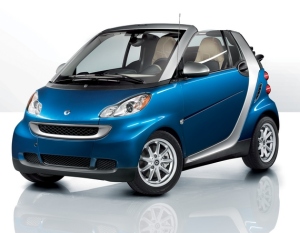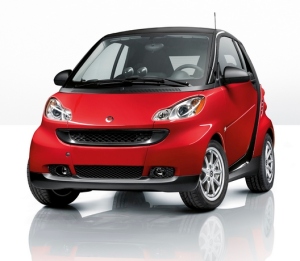 |
Lowering the top on the smart fortwo cabriolet is a breeze |
Parking a smart fortwo should be at the top of the list of Easiest Things in the World.
Even if the parking space is lilliputian, even if you have approached it from an odd angle, even if the cars on either side of you are gargantuan trucks, you should be able to squeeze into the space with room to spare.
I must confess that I was a little nervous to test driving the smart fortwo. Yes, I requested a loan of the car. After years of decrying the practice of individual people commuting in massive trucks, I decided it was time to squeeze myself into what is surely the tiniest car on the market today.
The two-passenger smart car's dimensions tell the story. Its total length is less than 9 feet - more than 3 feet shorter than the already compact Mini Cooper. The relative tinyness of the smart fortwo has an interesting effect on interactions with other drivers. You must drive defensively because some drivers will act as if they simply don't see you because it's impossible anything as small as a smart fortwo is actually on the road. On the other hand, there are also drivers who are also so charmed by the smart fortwo's cuteness that they will wave you along and give you some special deference, much as a tiger might refrain from chasing a canary.
Does the smart fortwo feel cramped inside? Not particularly. I stand over 6-feet tall and I had plenty of headroom, enough elbow room and just enough leg room.
Of course, you can't take long road trips in the smart fortwo - unless you put your luggage into a compacting machine first. If you want to see out the (small) rear window, don't count on holding more than your smallest suitcase and a couple of bags of groceries. That's all we managed to fit in the Smart's 7.8 cubic feet of cargo space (up to the belt line).
 |
| The smart fortwo coupe. Cute? You betcha. |
How about the smart fortwo's design? Cute as a button - and about the same size! :) People will stare. They may start conversations or ask to trade the smart fortwo for whatever gas-guzzler they're driving. Almost every time I parked the smart fortwo, I turned to marvel at how compact and fun it looked next to whatever staid minivan or sedan was parked next to it.
I thought the fit and finish of the inside components was generally pretty good. I liked the bold red accents on the dashboard and control panels.
I was also very impressed with the performance of the Cabriolet roof that opened and closed at the push of a button by sliding along a track at the top of the vehicle.
On the other hand, I would have exchanged the Passion Cabriolet's complicated audio system in a heartbeat for an interval windshield wiper system or cruise control.
So from a looks, design and fit standpoint, I was pretty pleased with the smart fortwo. Then I started driving it.
I had been a little trepidatious based on my advance read of several blogs including Edmunds and The Truth About Cars that excoriated the smart fortwo's transmission, acceleration and handling.
Basically, I wholeheartedly endorse their conclusions. I drove the Smart in urban traffic (Brooklyn, Manhattan), suburban (Long Island) and rural (Hudson Valley). If your commute involves very smooth, straight roads at moderate speeds of 40-50 mph, the smart fortwo could be a good car for you. But if your route involves winding roads, hills, highways where good acceleration is a must or the traffic flows around 70 mph, I would say that the smart fortwo could very well make for a scary ride.
I'm not refering to its size or safety characteristics. Smart has created a great website (SafeandSmart.com) with compelling personal anecdotes about the strength of the car's "safety cell" structure. I fully sort of believe that the safety cage would protect me in a crash, but I'd prefer to avoid getting in a crash in the first place and I had several occasions (off ramps, on ramps, hard turns, occasions that called for acceleration) where I felt that I was lucky to avoid collisions with other vehicles or the landscape in my smart fortwo.
And then there's the small matter of bumps in the road. Both my passenger and I actually had back pain after driving for several hours in the smart fortwo down admittedly very potholed and uneven highways in the NYC metro area. Yes, I blame the highways, but I've ridden electric bicycles that offered a smoother ride at 20 mph on New York's streets.
I could go on to talk about how the 'automated manual transmission' drove me crazy in both full automatic and semi-manual modes. Or about how the vibration and engine noise are exhausting even at low speeds, but you probably get the picture.
It's all a shame since the smart fortwo really is an attractive car from an eco-friendly standpoint. In mostly highway driving, I managed to get around 40 mpg, which is very impressive for a non-hybrid car.
Not only that, but the smart production process is pretty eco-friendly too, including the use of prefabricated modules at the French factory where smarts are produced, plus water-soluble paints, recyclable body panels and a power-coating of the safety cell that eliminates the need for solvents.
Heck, the car even has 'flax-based components' in its dashboard! How cool is that!
The car itself is classified as an Ultra-Low Emission Vehicle (ULEV). Smart's press materials trumpet the clever design of an electric pump that "blows fresh air into the exhaust port when the engine is cold to almost completely oxidize the carbon monoxide (CO) and hydrocarbons (HC) and render them harmless." Sounds good to me.
Truth be told, I would have a hard time recommending the current generation of the smart fortwo. As this blog attests, I'm pretty passionate about protecting the environment, but I also have minimum comfort and handling thresholds when it comes to assessing a car and smart fortwo didn't meet them.
On the other hand, I'm still excited about the news that smart is planning an electric version of the fortwo, expected to arrive in the US (via pilot programs) in late 2010. With any luck, the electric car will have better and smoother acceleration. If so - and if smart can improve handling and shock absorption - the electric smart car could be a very smart choice indeed.
Where to buy -
Purchase a smart fortwo at a Dealer near you.
The smart fortwo Passion Cabriolet starts at $16,990, but a few options (like power steering) and destination charge brought the model I tested up to just $17,980.
According to the smart website, there is a base Pure Coupe that lists for under $12,000, but expect to pay extra for options such as air conditioning and radio.
Disclosure - Smart USA lent me a smart fortwo Passion Cabriolet to review.
No comments:
Post a Comment